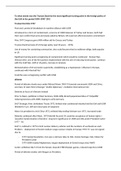To what extent was the Truman Doctrine the most significant turning point in the foreign policy of
the USA in the period 1890-1990? [30]
Truman Doctrine 1947
Post ww2, period of breakdown in wartime alliance with USSR
Introduced as a form of containment, concerns of USSR takeover of Turkey and Greece, both had
their own conflict that were previously aided by Britain, UK could not afford economic commitment
May 1947 Congress gave $400 million aid for Greece and Turkey
Truman Doctrine basis of US foreign policy next 30 years – 1970s
Use of money for containing communism, also could be perceived as noblesse oblige, both popular
in US
Significant turning point as beginning of containment which would be continued – Korean War,
Vietnam War. one of the first policies implemented with the aim of reducing Soviet power, continue
with the Cold War, shift in US policy, increase in tensions
Demonstration of US economic superiority, establishing as a Superpower, influence in Europe,
continued with Marshall Aid
Could be seen as beginning conflict with USSR
détente
Period of détente clearly seen under Richard Nixon 1969-74 towards communist USSR and China,
secretary of state Henry Kissinger ‘shuttle diplomacy’, mediative international role
Detente as focus on Vietnam instead
Prior to Nixon, politician in West Germany 1960s Willy Brandt popularised idea of ‘Ostpolitik’
reducing tensions with USSR, hoping to unify Germany
SALT Strategic Arms Limitations Treaty 1972, limited inter-continental missiles held by USA and USSR
(limited to 5 yrs, left out many types of weapons)
Nixon 1st president to visit China 1972, enlisted help ending Vietnam war 1975, increased trade
Détente continued after Nixon, 1975 Helsinki Accords 35 countries acceptance of human rights +
‘peaceful transformation of borders’, long term significance in USSR and USA under President Carter
1977 – 81
SALT 2, outlined in 1979 to limit nuclear delivery vehicles and the numbers of warheads on each.
Problem – deployment of Soviet medium-range nuclear missiles in Europe 1976-77, was not signed
due to:
- 1979 Iranian Revolution, Iran was a cold war alley to USA. Iranian hostage crisis, failure for
President Carter
- 1979 USSR invaded Afghanistan, largest deployment of Soviet troops since WW2
Carter: withdrew SALT 2 from the Senate, boycott 1980 Olympic games, reduced exports to USSR
Period of détente ended, with Reagan as President.
, WW1
Originally 1914 proclaimed neutral by Wilson, advantageous to US economy and industries
Neutrality unofficially broken by:
War loans - $2 billion to allies, $27 million to Germany
18 December 1916 ‘Peace Note’
22 January 1917 ‘peace without victory’ speech, , turning point as US president asserting
international leadership
Provoked to war by: 1915 sinking of US passenger ship Lusitania by Germans, 1917 Zimmerman
telegram
Contrast to previous isolationist policies
Military efforts gained global influence – March 1918 30,000 US troops in France, November 1918 2
million
January 1918 Wilsons 14 Points – US aims to dominant post-war world, attempt international
influence, emphasised self-determination, largely unsuccessful due to uncommitted responses,
calling for League of Nations established
Successes establishing League of Nations – spread of US democratic values, gaining power,
Wilsonian internationalism
Wilson key role at 1919 Versailles Peace Treaty Conference, US position as major power
WW2
Particularly turning point in contrast to isolationist 1930s, economic recovery
Congress had passed neutrality acts: 1935, 1936, 1937 yet not exclusively isolationist, with congress
passing 1938 Naval Expansion Act and 1939 Roosevelt gained $25 million to expand air force
Roosevelt’s move to support Britain: 1940 lend-lease $7 billion, 1941 Atlantic Charter informal
alliance, US destroyer Greer attacked by U-boat exploited by Roosevelt, despite Greer shadowing the
boat and reporting to the British, next month USS Kearney and USS Reuben Jones attacked by U-
boats, Congress repealed neutralities acts, US joined war 7 th December 1941 after Japan bombing
pearl harbour
Economic – expansion of Us productive capacity to provide for allies and themselves, manufacturing
output doubled 1941 – 45, produced 300,000 aircraft, 1945 largest navy in world, 1945 15 million in
military service, large contribution to allied victory
Military – US fighting, Europe, Mediterranean, north Africa, Eisenhower – Supreme Commander of
allied expeditionary force, Manhattan project, atomic bomb, 1942 – 43 US ‘island hopping’, 1945
Truman instructed Hiroshima and Nagasaki
Post WW2 policy of massive rearmament and collective security, stationing troops abroad and
missiles overseas, monopoly on atomic bomb, military-industrial complex





